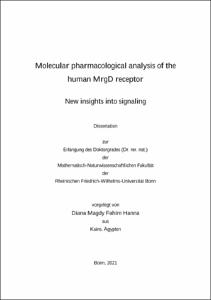Hanna, Diana Magdy Fahim: Molecular pharmacological analysis of the human MrgD receptor : New insights into signaling. - Bonn, 2021. - Dissertation, Rheinische Friedrich-Wilhelms-Universität Bonn.
Online-Ausgabe in bonndoc: https://nbn-resolving.org/urn:nbn:de:hbz:5-63451
Online-Ausgabe in bonndoc: https://nbn-resolving.org/urn:nbn:de:hbz:5-63451
@phdthesis{handle:20.500.11811/9267,
urn: https://nbn-resolving.org/urn:nbn:de:hbz:5-63451,
author = {{Diana Magdy Fahim Hanna}},
title = {Molecular pharmacological analysis of the human MrgD receptor : New insights into signaling},
school = {Rheinische Friedrich-Wilhelms-Universität Bonn},
year = 2021,
month = aug,
note = {Introduction: MrgD is a member of the MAS-related GPCRs family. It has been proposed to play roles in nociception and cardiovascular control. MrgD has been shown to couple to Gq, Gi, and Gs proteins. The amino acid β-alanine and the peptide alamandine act as agonists. Antipsychotics like chlorpromazine and related structures act as low affinity antagonists. In the present study, the human MrgD receptor signaling was further characterized using potential agonists and antagonists and a possible coupling to the β-arrestin pathway was addressed.
Methods: G protein-dependent functional assays including Fluo-4 calcium, Nuclear Factor of Activated T cells (NFAT)-reporter gene, and AlphaScreen cAMP assays were used to study the interaction in cloned Chinese hamster ovary (CHO) Flp-In cells stably expressing a variant of the human MrgD receptor. Receptor coupling to the β-arrestin pathway was studied using the PathHunter β-arrestin recruitment GPCR assay (Pro-link tagged human MrgD and enzyme-acceptor-tagged β-arrestin-2 co-expressed in CHO-K1 cells).
Results: In CHO cells expressing the human MrgD receptor, β-alanine (300 µM, 1 mM, and 3 mM) caused strong and concentration-dependent Fluo-4 fluorescence increases which were not observed in non-transfected CHO cells. Interestingly, alamandine (10 µM) induced small, and short-lasting fluorescence increases which were similar both in receptor expressing and in control cells. As expected, and previously reported, β-alanine (300 µM) significantly inhibited forskolin-induced cAMP accumulation only in receptor expressing cells. In contrast, alamandine (0.0001 nM to 10 nM) increased the cAMP accumulation with a biphasic concentration-response curve in both cell lines. In CHO-K1 cells stably co-expressing the human MrgD and β-arrestin-2, β-alanine (30 µM to 1 mM) significantly recruited β-arrestin-2 while alamandine (0.00001 nM to 100 µM) stimulated only a weak response. DL-3-aminoisobutyric acid (30 µM to 3 mM), DL-3-aminobutyric acid (100 µM to 3 mM), and GABA (300 µM to 3 mM) activated the β-arrestin pathway with different potencies. Surprisingly, incubation either with chlorpromazine (10 µM) or thioridazine (10 µM) or rimcazole (20 µM) failed to inhibit β-alanine-induced recruitment of β-arrestin-2.
Conclusion: The present work provides first evidence on the human MrgD receptor coupling to the β-arrestin pathway. In addition, the data may indicate the biased coupling of the receptor to signaling transduction pathways.},
url = {https://hdl.handle.net/20.500.11811/9267}
}
urn: https://nbn-resolving.org/urn:nbn:de:hbz:5-63451,
author = {{Diana Magdy Fahim Hanna}},
title = {Molecular pharmacological analysis of the human MrgD receptor : New insights into signaling},
school = {Rheinische Friedrich-Wilhelms-Universität Bonn},
year = 2021,
month = aug,
note = {Introduction: MrgD is a member of the MAS-related GPCRs family. It has been proposed to play roles in nociception and cardiovascular control. MrgD has been shown to couple to Gq, Gi, and Gs proteins. The amino acid β-alanine and the peptide alamandine act as agonists. Antipsychotics like chlorpromazine and related structures act as low affinity antagonists. In the present study, the human MrgD receptor signaling was further characterized using potential agonists and antagonists and a possible coupling to the β-arrestin pathway was addressed.
Methods: G protein-dependent functional assays including Fluo-4 calcium, Nuclear Factor of Activated T cells (NFAT)-reporter gene, and AlphaScreen cAMP assays were used to study the interaction in cloned Chinese hamster ovary (CHO) Flp-In cells stably expressing a variant of the human MrgD receptor. Receptor coupling to the β-arrestin pathway was studied using the PathHunter β-arrestin recruitment GPCR assay (Pro-link tagged human MrgD and enzyme-acceptor-tagged β-arrestin-2 co-expressed in CHO-K1 cells).
Results: In CHO cells expressing the human MrgD receptor, β-alanine (300 µM, 1 mM, and 3 mM) caused strong and concentration-dependent Fluo-4 fluorescence increases which were not observed in non-transfected CHO cells. Interestingly, alamandine (10 µM) induced small, and short-lasting fluorescence increases which were similar both in receptor expressing and in control cells. As expected, and previously reported, β-alanine (300 µM) significantly inhibited forskolin-induced cAMP accumulation only in receptor expressing cells. In contrast, alamandine (0.0001 nM to 10 nM) increased the cAMP accumulation with a biphasic concentration-response curve in both cell lines. In CHO-K1 cells stably co-expressing the human MrgD and β-arrestin-2, β-alanine (30 µM to 1 mM) significantly recruited β-arrestin-2 while alamandine (0.00001 nM to 100 µM) stimulated only a weak response. DL-3-aminoisobutyric acid (30 µM to 3 mM), DL-3-aminobutyric acid (100 µM to 3 mM), and GABA (300 µM to 3 mM) activated the β-arrestin pathway with different potencies. Surprisingly, incubation either with chlorpromazine (10 µM) or thioridazine (10 µM) or rimcazole (20 µM) failed to inhibit β-alanine-induced recruitment of β-arrestin-2.
Conclusion: The present work provides first evidence on the human MrgD receptor coupling to the β-arrestin pathway. In addition, the data may indicate the biased coupling of the receptor to signaling transduction pathways.},
url = {https://hdl.handle.net/20.500.11811/9267}
}






